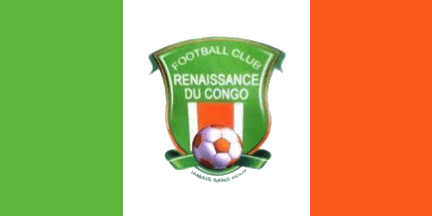 image
by Ivan Sache, 16 June 2019
image
by Ivan Sache, 16 June 2019
Last modified: 2019-08-19 by bruce berry
Keywords: congo | tp mazembe fc | olympics |
Links: FOTW homepage |
search |
disclaimer and copyright |
write us |
mirrors
See also:
 image
by Ivan Sache, 16 June 2019
image
by Ivan Sache, 16 June 2019
Football Club Renaissance du Congo (FCR) and nicknamed "the Orange Club" was
established on 16 June 2014 in Kinshasa, as Club
Sportif Imana, seceding from Daring Club Motema Pembe (itself renamed to Daring
Club Motema Imana in 2015). FCR adopted its definitive name one month later.
FCR won the 2016 Cup of Congo against CS Don Bosco (2-0) and was promoted to the
top league (Linafoot) for the 2016-2017 season. FCR was ranked 3rd in the
West Regional Division, advancing to the national, (final round) where it was
ranked 8th and last. In the 2017-2018 season, FCR was ranked 8th in the West
Regional Division.
An internal crisis broke out in the beginning of the 2018-2019 season after FCR
started the season with a defeat to AC Rangers (0-2) and a draw with Dragons
(0-0). On 06 October, the club lost at home 0-6 to Tout
Puissant Mazembe. Bishop Pascal Mukuna, the founding president of the FCR,
sacked the coach, Chico Mukeba. After he was bitterly criticized for his
management, having also marginalized the two other co-founders of the club,
Antoine Musanganya and Roger N’Singi, and suppressed the Barumbu supporter's
section, Mukuna resigned from the presidency on 11 October 2010. The club's
situation subsequently improved with FCR ranked 9th out of 16 in the final
classification of Linafoot (organized that season in a single, national
division).
In the aftermath of his victory in the Cup of Congo, FCR qualified for the 2017
CAF Confederation Cup. The club was defeated in the preliminary round by Akanga
FC (Gabon), 0-0 and 0-1.
The flag of FCR is vertically divided light green-white-orange (~2:3:2) with the
club's emblem in the center.
Ivan Sache, 16 June 2019
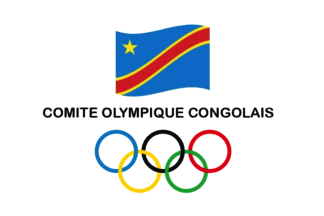 Image by Tomislav Šipek, 13
June 2018
Image by Tomislav Šipek, 13
June 2018
The flag of the Olympic Committee of the Democratic Republic of Congo has a
white background with the Olympic Committee logo in the centre.
Tomislav Šipek, 13 June
2018
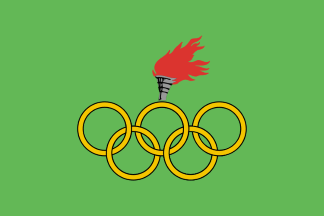 Image by Zachary Harden, 12 June 2018
Image by Zachary Harden, 12 June 2018
The Zaire Olympic Committee (Comité national olympique zaïrois, IOC Code
ZAI) was a continuation of the DR Congo Olympic Committee which was initially
formed in 1963 and was recognized by the
International Olympic Committee on 31 December
1967. DR Congo used this name between 1971 until 1997 and first competed as
Zaire in 1984 Los Angeles Summer Olympic Games. It was not until the 2000 Sydney
Games that Zaire was changed back to DR Congo.
According to "3 mars 1976 DÉCISION OLYMPIQUE 003/76 portant création et
protection des emblèmes olympiques du Comité national olympique zaïrois" (3
March 1976 - Olympic Decision 003/76 - The creation and protection of the
Olympic Emblems and of the Zaire National Olympic Committee) a flag that
was created for the Olympic Committee.
According to the
law, the flag used at that time was green with the golden Olympic rings in
the centre. Above the rings was a grey torch with a red flame similar to
that found on the national flag used at that time.
Unfortunately, there is no picture of the flag or emblem to confirm this and the
illustration above is based on the badge used at the 1988 Games.
Zachary Harden, 12 June 2018
TP Mazembe (nicknamed "The Ravens") is the most successful football club in
Democratic Republic of Congo. The club was established in 1939 in
Elisabethville (now Lubumbashi) by the Benedictine
missionaries who managed the Saint-Boniface Institute. Named FC Saint Georges
for the Scouts' patron saint, the club was registered in the First League of the
Fédération Royale des Associations Sportives Indigènes (FRASI). The Club
was renamed the Saint Paul FC in 1944. The Club was subsequently taken
over by a tyre manufacturing company, Englebert, and accordingly renamed to FC
Englebert. In its first season, the newly renamed club was undefeated and
won the League. This was celebrated by a adding "Tout Puissant" (All
Mighty") to the club's name.
TP Mazembe has won 17 national championships and five Cups of Congo. The
club played four finals of the African Cup of Champions Clubs in a row, winning
in 1967 (to Asante Kotoko, Ghana: 1-1, 2-2) and 1968 (to
Étoile Filante de Lomé, Togo: 5-0, 1-4), and being
defeated the next two years (1969 to Ismaily FC, Egypt:
2-2; 1-3; 1970 to Asante Kotoko, Ghana: 1-1, 1-2) ). Up to
now TP Englebert is the only club to have won
two Champions' Cup in a row.
After a long period of absence from the continental scene, TP Mazembe won the
African Cup Winners' Cup in 1980 (to Africa Sports, Côte
d'Ivoire: 3-1, 1-0), a third Champions League in 2009 (to Heartland FC,
Nigeria: 1-2, 1-0), a fourth one in 2010 (to Espérance
Sportive de Tunis, Tunisia: 5-0, 1-1), and a fifth in 2015
(to USM Algiers, Algeria: 2-1, 2-0).
Ivan Sache, 16 June 2019
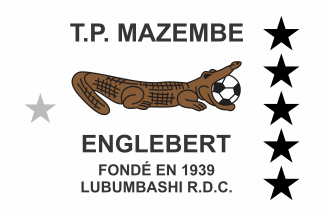 image by Juan Manuel Gabino Villascán, 18 Dec 2015
image by Juan Manuel Gabino Villascán, 18 Dec 2015
TP Mazembe Football Club is located in Lubumbashi, Democratic Republic of Congo. It was one of eight teams to compete in the FIFA Club World Cup in Japan in December 2015.
TP Mazembe FC used a very elaborate flag which has a white background with five
black five-pointed stars arranged vertically in the fly and one silver (grey)
five pointed star in the centre near the hoist. The club's logo, a brown
crocodile holding a football in its mouth, is in the center of the flag
surrounded by the team’s name and foundation year.
Juan Manuel Gabino Villascán, 18 Dec 2015
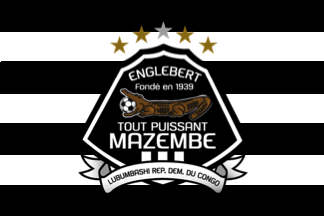 image by Ivan Sache, 16 June 2019
image by Ivan Sache, 16 June 2019
An image
here shows another variant of the club's flag which comprises seven equal
horizontal black and white stripes, four black and three white, with the club's
new
crest in the centre. Another flag variant can be seen on their official
Facebook profile
picture gallery.
Esteban Rivera, 19 Dec 2015